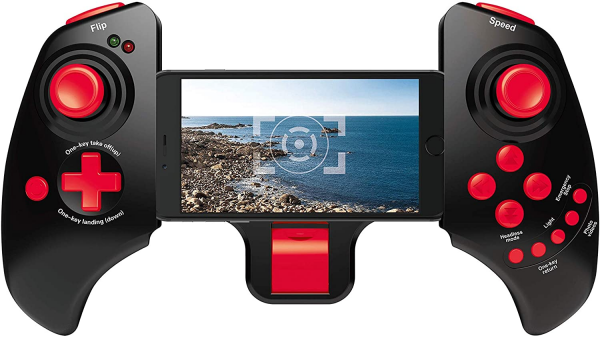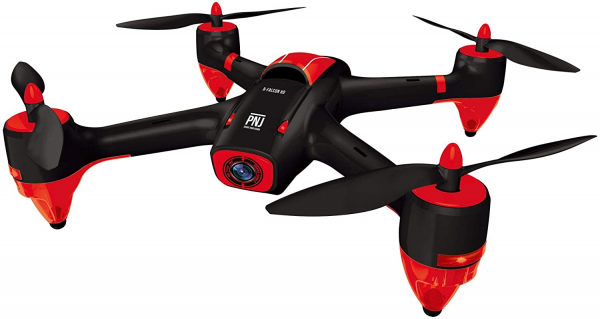PNJ
PNJ R-Falcon HD: HD for viewing, not for filming
Aprox. 99€
See specificationsPresented as a drone "designed for the pleasure of thrill seekers" thanks to its camera allowing a flight in immersion, the R-Falcon HD from PNJ would be just as suitable for taking pictures. Promises that we have not really found in practice ...
Positive points
Easy to use.
Propeller protections for beginners.
Smartphone application with video feedback from the camera.
The remote controller supporting the smartphone is provided.
Bad points
Poor photo and video quality / No image stabilization.
Low range.
Caught in the wind.
Lack of power.
No holding in a horizontal position.
Our review
Presentation
Among the string of low-cost drones in the PNJ catalog, there are in particular mini-drones which have no other objective than to provide piloting pleasure to novice or experienced users. But there are also more imposing ones, dedicated to racing, or others who go so far as to proudly highlight their more or less HD camera to hope to set foot in the universe of drones oriented shots. The R-Falcon HD plays on several tables, but insofar as it is aimed more at beginners and is only equipped with a 720p HD camera, we have chosen to put it in our comparison of playful drones rather than in that of drones oriented shots where it could not have hoisted even if only the ankle of its competitors. With a floor price of € 99.99, it can not do miracles anyway, so it is better to consider it above all as a small flying toy.

Getting started
Despite its playful vocation, the R-Falcon HD remains relatively impressive. With approximately 27 cm diagonally from one engine axis to another, 22 cm side (without propellers) and 7 cm thick for 153 g, this quadrotor is thus much closer to a Parrot Bebop 2 (328 x 382 x 89 mm) than a Ryze Tello (177 x 177 x 40 mm), for example.
Surprising, insofar as its battery is quite small and it does not carry anything other than a camera of the same definition as that of the Tello, precisely. A template that handicaps him when talking about transport, since it is not easily slipped into a backpack. In addition, it is better to avoid using it indoors for the same reason, although propeller protections are provided. PNJ also takes care to specify that if there is domestic flight, it is preferable to have large volumes without obstacle.
In terms of manufacturing quality, no real surprise for a drone at 100 €, the shiny plastic is quite low-end, but this is correct for such a device that wants to be more toy than anything else. The chassis remains quite rigid and it is the main thing to prevent it from breaking at the slightest crash.
A joystick-shaped remote control is provided with the R-Falcon HD. This can be used directly with the drone, the pairing being done automatically. We then have all the basic commands, with buttons for automatic takeoff and landing, emergency stop, automatic return or flight speed selection. There too, the impression of holding a toy in the hands is significant, but it is the case with the vast majority of drones at low prices.
To fully exploit the device, it is however recommended to connect it via Wi-Fi with a smartphone or a tablet (Android or iOS), then use the R-Falcon HD app to take advantage of all its functions and of real-time video feedback from his camera. We can then control directly from the touch interface or continue to use the radio control, which is also designed to accommodate the smartphone or tablet (up to approximately 20 cm in length).
The application could be clearer, since we do not always know what the icons are for, all arranged at the top of the screen and without any textual explanation. You have to refer to the manual and it's a bit of a shame for a device supposed to be easy to use.
Flight
The R-Falcon HD can take off at the touch of a button to position itself about 1 m above its starting point. Lack of sensors, unfortunately it can not stay in place for a long time and drifts quickly enough, even if you adjust its position with the trims of the radio control. It nevertheless keeps roughly its height and this is also reflected in the way it controls itself. The left stick is used to raise or lower the quadrotor. It therefore does not act directly on gases; if released, it returns to the central position and the quad does not descend; you have to tilt it down for that. This allows easy piloting for beginners, especially since the controls are quite soft, especially in the first speed mode. For a little more nervousness, we can engage the 2nd or 3rd mode, which allow slightly sharper acceleration and higher speeds. This is nevertheless very wise, it is not a racing drone. The motors (with brushes) are also not very powerful, which means anticipating changes in direction and especially stops so as not to drift and risk hitting an obstacle. Too bad, because it is precisely on this aspect that the R-Falcon HD could have distinguished itself from a mini-drone.
As it stands, its size and 155 mm propellers only serve to make the drone a little more stable, especially outdoors. Problem, the lack of power and stabilization is sorely felt when there is a little wind. So much so that at the end of the battery, it can happen that it can no longer even advance against the wind.
In terms of flight modes, we have the headless (headless) which eliminates the need to worry about the orientation of the drone. If we orient the right stick to the right, the device goes to the right, if we pull it towards us, it gets closer ... Practical when you no longer know how to distinguish the front from the rear, for example. However, it is better not to move the radio control to stay on the same axis. In the worst case, an automatic back button is available, but the accuracy leaves something to be desired. Fans of gyroscopic control will be happy to learn that they can opt for "sensory piloting" and thus control the drone simply by tilting their smartphone in the direction towards which they wish to have the device turned. Somewhat gimmicky, but why not after all ...
Image quality
Even if the official page of the R-Falcon HD talks about making "breathtaking aerial shots", we did not expect much from the modest 720p camera it embeds. And we were right, since if there is breath taking, it is rather because of the low quality obtained than thanks to the "superb photos and aerial videos" that PNJ promised us.
The image quality is hardly worthy of a webcam, only the colorimetry is more or less respected. The image unfortunately turns to the mush of pixels very quickly for lack of any stabilization. Even when the drone is on the ground, the definition is still insufficient and the wide-angle optics far too bad to hope to get anything out of it. The little Ryze Tello manages to do better despite its small size. Stay on the ground with your smartphone, it will always be less disappointing than an aerial mush of pixels.
If aerial photography is therefore not the strong point of the R-Falcon HD, we were hoping at least to take advantage of its camera to pilot in immersion. Alas, the result is just as disappointing. Although the quality is fortunately a little better than that obtained with an analog link as found in drones designed for the FPV (mini-drones such as the Fat Shark 101 or the Eachine UK / US65), it is not no longer the panacea. Above all, the connection via Wi-Fi is much less reactive and we must then deal with a fairly high latency, which destroys any hope of driving in immersion in the middle of obstacles (trees, tables or other elements of a garden). A "3D" mode, however, allows you to divide the display in 2 to use the smartphone in a compatible VR headset, but experience is not recommended.
The range is also limited to 30 m, there is no point in hoping to discover the surroundings, otherwise you will lose the video feedback and then control the drone. A loss of connection which is troublesome, since the device does not automatically return in this case and is allowed to drift until impact. Not necessarily enough to lose it at the first opportunity, but we must prepare to go and recover it. Again, it is best not to take it out if there is a little wind.
Autonomy
PNJ announces an autonomy of 10 minutes with the Li-Po battery of 850 mAh supplied. It's a bit optimistic, but we can actually exceed 9 minutes in wise flight. It was without taking into account the loss of power that one meets under a certain level of battery, which makes piloting complicated and even uninteresting as the device no longer has juice. Table therefore more reasonably on 6 or 7 minutes, knowing that in speed mode 3, the range drops even faster. In absolute terms, it is always better than most mini-drones which very often only fly 3 to 4 minutes with a battery.
PNJ sells batteries at € 19.99 per unit if you wish to fly longer. Good point, their recharging is done directly via their integrated micro-USB port. An indicator light comes on during charging and goes out when the battery is charged. Li-Po requires, however, care must be taken to disconnect it at the end of the charge, that is to say after approximately 1 h 15 min (strangely much less than the 120 minutes announced by PNJ) with the cable provided, which must be connected to the computer. Although this is tempting, it is better to avoid charging the battery with a smartphone charger which would supply too much current and risk damaging it. PNJ indeed recommends an intensity of 0.5 A only during charging.
Conclusion
Too limited in video to compete with a real drone designed for shooting, too slow in FPV to fly in immersion while avoiding obstacles and too big to fly indoors, the R-Falcon HD does not assert itself on any particular terrain. Its low price is not enough to make it really interesting in front of mini-drones which ultimately film not less well and are much more fun to fly.
Specifications

